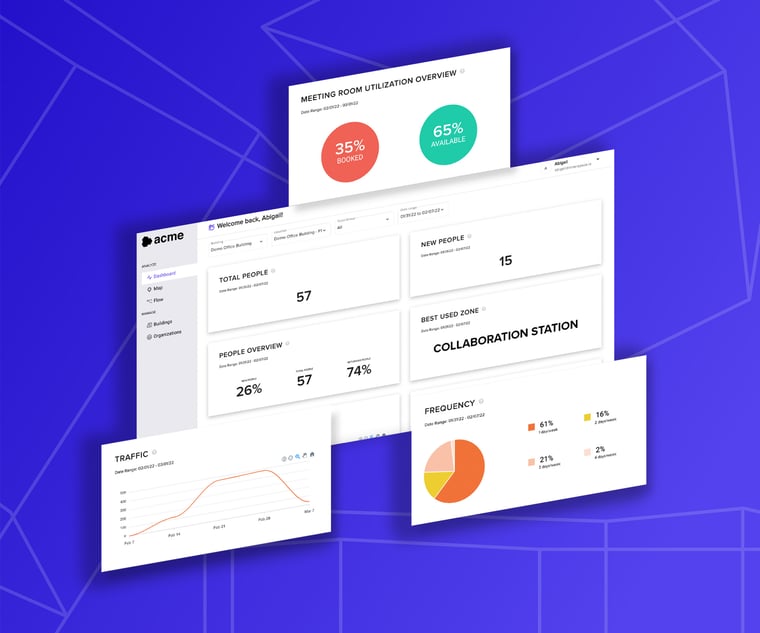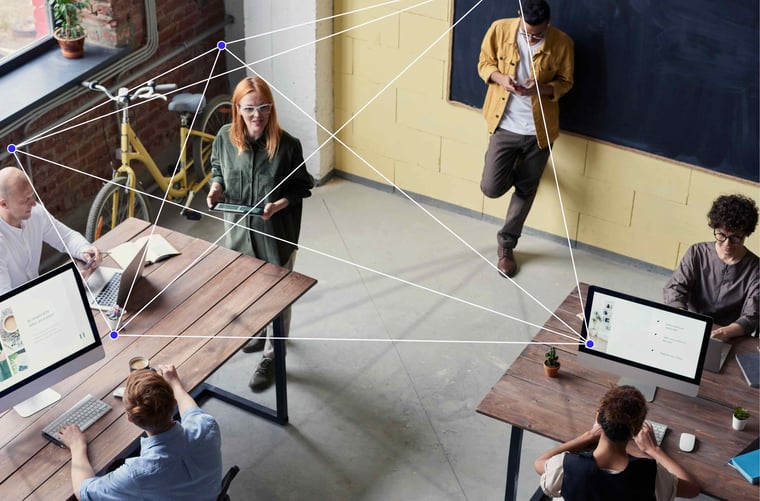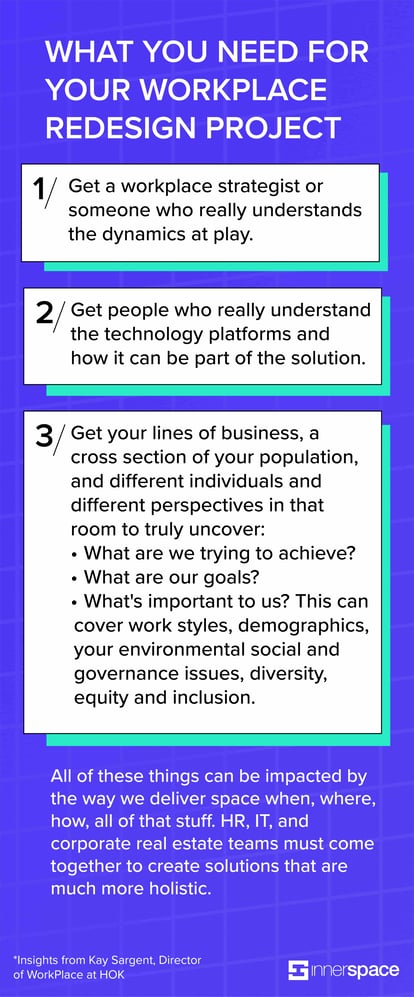Key Considerations for Workplace Design in 2023
In today's rapidly evolving world, the concept of the workplace has transformed beyond a physical setting for work. It has become an entire experience that encompasses the way we work, when we work, and where we work.
 Designing a workplace that caters to these dynamic needs requires careful consideration and strategic planning. We recently spoke with Kay Sargent, a Director of HOK’s Global WorkPlace practice, who shared insights regarding the non-negotiables of workplace design and overall a strategic vision of how to approach the new hybrid model.
Designing a workplace that caters to these dynamic needs requires careful consideration and strategic planning. We recently spoke with Kay Sargent, a Director of HOK’s Global WorkPlace practice, who shared insights regarding the non-negotiables of workplace design and overall a strategic vision of how to approach the new hybrid model.
The workplace must transform from a place we 'go to do our work' to a space that enables us to ‘do our work better’. Why should we spend hours commuting and pay for lunch at the office, when we have everything we need at home? The workplace must provide something unique.
Below we will explore these insights, shedding light on the importance of forward-thinking workplace experience, operational models, and human-centric office spaces in creating successful workplaces.
Workplace Design Trends that Accommodate New Ways of Working
As work continues to evolve, workplace design must adapt to meet the changing needs of employees and organizations. Kay said “We've never lived in a time where things have evolved as quickly as they're evolving now, and we will never again live in a time where they evolve as slowly. So things just keep changing. And I think what we have to help our clients do is understand the days of one and done. And then you let your space sit for ten years and then you revisit it in ten years is a recipe for failure. We really need to create spaces that we can reassess, adjust and be agile and responsive. Otherwise, your space becomes a weight. And that's not what we want.”
Workplaces can no longer simply consider the look and feel of an office or maintain the status quo in workplace design but must now consider how their spaces specifically enable flexibility, collaboration and productivity. From incorporating collaborative spaces to reimagining the role of the office, organizations must embrace these trends to create future-ready work environments. It’s time to get rid of the ‘let’s put in a foosball table and provide all the snacks’ mentality and think about the different kinds of people in the workplace and what their needs are. Think about the creatives in your workplace, The Creative needs the best of both worlds in order to truly thrive. Space for collaboration and brainstorming with their team is critical. At the same time, however, they also need opportunities to focus, removed from distractions, and to be left alone with their thoughts. They want flexibility to nurture creative thinking and the curation of ideas.
Hybrid Work: Focusing on Collaborative Spaces and Workplace Design
The rise of hybrid work has necessitated a reevaluation of workplace design. It’s important to create collaborative spaces that support both in-person and remote collaboration. It emphasizes the need for agile and adaptable design solutions that foster connectivity and engagement among employees, regardless of their physical location. Think about our creative employee from above. They love the freedom that hybrid working has given them, but they don’t always find it easy to think creatively and out-of-the-box in a dull, unengaging office. The creative employee needs somewhere that is lively and inspires creativity, with an atmosphere that is bold and fun.
As Kay emphasizes, "The design community has got a break to have it. The largest rectangular table I can shove into a room with the maximum number of chairs in the tightest confinement I can, with windows on one side, a total glass wall on the other, and a little tiny screen at the end of the room and call that a good cover. That has sucked for 10 years and it sucks today. We really need to rethink that. That's not an enticing space. If people are coming in and people are coming in together to socialize, are you creating areas for people to truly do that? But are you also acknowledging that they need to also maybe process before they walk into a meeting and process that information after the meeting, and they still need that heads-down space. And that we now have a heightened sensitivity to sound because we've all been living in our own little private zones. And so we have to reacclimate a little bit. But also, totally quiet spaces aren't good."
These insights highlight the importance of creating diverse and flexible spaces that cater to different work modes, promote social interactions, and provide opportunities for focused work. And when ‘quiet quitters’ make up at least 50% of the US workforce, keeping your teams engaged should be at the top of your agenda. It is crucial to strike a balance between collaboration and individual work, as well as provide spaces that accommodate the changing needs and preferences of employees in a hybrid model.
The Hybrid Model is Not a One-Size-Fits-All
Hybrid work isn't a blanket solution– it's a flexible framework that needs to be tailored to meet the specific requirements of different roles, industries, and individuals. For some roles, the hybrid balance might lean towards 80% remote, 20% office-based. For others, it might be a straight 50-50 split. It all depends on the unique demands and dynamics of each role. Not every role or industry suits the hybrid format. Some roles, like a high-turnover outbound call center, might need more hands-on management and in-office presence. That said, highly skilled industries with well-paid employees who juggle a multitude of tasks could see the value in a hybrid model.
Kay emphasized “Hybrid is also the hardest model to pull off. And if you think you can just change and just say, Okay, you can work from home one or two days after our hybrid policy, you're wrong. You need to think about how you onboarding people? How are you retraining managers to manage by performance and not presence? What is required? How do you ensure that you don't have proximity bias or you're not creating silos? We've worked with a lot of companies that have had really successful remote and or hybrid programs that have gone off the rails because if not done well, it can be the worst of it.”
Remember, hybrid work is not 'one-size-fits-all'. It's a spectrum. The key is to find the right balance on the hybrid spectrum that works for you and your team.
Although the hybrid work model is currently popular amongst companies post-pandemic, employees are expressing concerns about it creating segregation between remote and on-site staff.
The inequity primarily stems from commuting.
On-site employees believe that they have to unfairly compensate for long commute times, and balance the cost of commuting, while their remote work colleagues do not.
“You can commute to an office to sit on Zoom calls all day and be like, Why did I come here? Or you could go to a place that actually has worse Wi-Fi than where you started, or you could be going to a loud space when what you needed that day was a quiet space, and that's where you started your day. So I think there's a lot of things that still need to be worked out. And it is not for the faint of heart.” Kay notes.
The need to anticipate these costs acts as a de-facto pay cut, one which employers do not have the budget to balance out. Most businesses are under a considerable amount of pressure to ensure the hybrid office space works. In order to solve a portion of this puzzle, companies must glean a combination of information.
Often employers aim to gain data about the happenings of their physical space first. This is important, however it is more powerful when combined with data relating to the happenings in their employees minds.
Together, these paint a fuller picture of the problem with space utilization data.

This quantitative data helps employers and employees alike understand how office space is being used. However, it is important to understand that this data is not stagnant. It must be constantly measured and re-measured, because change is always evolving.
Similarly, office space should evolve over time with regards to its need and use.
Design Matters More Than Ever
Kay also touched on the notion that in today’s workplace, design must go beyond aesthetics "A pretty space is always nice. But that's not really all it's about. And I think another thing, a lot of our clients are saying, What is that amenity that's going to get everybody here? There are some great amenities that people should be thinking about." Kay said "Quite frankly, they always should have been thinking about it. But now I think what they also need to realize is that people are the number one amenity. If I create an amazing space but nobody's there, it's not great. It's like if you go to a restaurant and you're the only person in the restaurant, it's not a good experience. I don't care how great the experience is."
The success of your organization hinges on your people. Employee experience plays a pivotal role in shaping your culture, productivity levels, reputation, and talent acquisition. To thrive, you must prioritize equipping your workforce with the necessary tools to excel. However, there has been a noticeable shift in your employees' values. Quality of life and well being have taken precedence over salary for office workers. Factors such as inflexibility and inadequate workspaces that fail to cater to their needs have emerged as significant contributors to job dissatisfaction and attrition.
The Workplace Is a Magnet, Not a Mandate
An office space that your employees gravitate towards is one that is customized to their unique ways of working. It boasts built-in functionality, seamless usability, and greater opportunities for social connection. And perhaps most importantly, it ensures a productive, engaging environment where your staff can produce their best work, leading to a competitive advantage for your organization.

The impact of design on employee experience, productivity, and well-being. It highlights the need for thoughtful design choices that consider factors such as lighting, ergonomics, acoustics, and overall ambiance to create spaces that inspire and support employees. “If people are coming in and people are coming in together and socialize, are you creating areas for people to truly do that? But are you also acknowledging that they need to also maybe process before they walk into a meeting and process that information after the meeting, and they still need that heads down space.” Kay said. “And that we now have a heightened sensitivity to sound because we've all been living in our own little private zones. And so we have to reacclimate a little bit.”
A Note On Sustainability
When it comes to the sustainability of corporate real estate, it's not about doing less– it's about doing more efficiently. With studies showing 30-40% of office space often underutilized, imagine the possibilities if we used this 'wasted space' more effectively. Our existing office buildings might still have a carbon footprint, but picture the CO2 saved when a company occupies an existing building instead of constructing a new one. Think about it in terms of square foot per employee. If we can accommodate twice as many people in the same footprint, we've effectively halved our per capita carbon emissions and made the most efficient use of space. Maximize existing spaces before expanding our carbon footprint. That's the future of sustainability: better, not bigger.
The Human-Centric Way Forward
Organizations must adapt to this new reality, considering employee preferences, work-life balance, and well being as key considerations in workplace design. And that must come from tying it all together “, your policies and your procedures, your cultural and what that is and what you want it to be, your space and ensuring that it's really truly fit for purpose, and understanding if you're coming in because you want to connect with the brand or the culture, you want to connect with others, and you want to be able to do your job, then making sure that we're really creating environments and a culture that supports all of those things.” Kay notes.
Creating a future-ready workplace requires a deep understanding of how your office space is being used, the impact of technology, and the changing dynamics of work.

By embracing collaborative spaces, prioritizing flexibility, and focusing on employee well-being– and overall human-centric approach, organizations can create workplaces that not only meet the needs of today but also adapt to the needs of the future.
This focus on space utilization and social environment is especially pertinent as companies continue to use the hybrid model. However, it is important to remember that every company is different.
The physical space and social needs of one team can vary drastically compared to another.
The specific office space requirements of an engineering team and a communications team are not the same.
Superior space utilization insights can help managers ensure that their office space meets the unique needs of their team, which in turn helps maximize productivity and culture.
Offices need to work for everyone, because every team works differently. There is no one size fits all.
The key considerations of workplace design outlined above serves as a guide for organizations to navigate this ever-evolving landscape successfully.
Want to know more about how space utilization insights can help? We’d love to set up a call.
Accurate space utilization data through Wi-Fi?
We'll prove it to you.
See why industry leaders leverage InnerSpace to generate valuable insights that go beyond occupancy.

